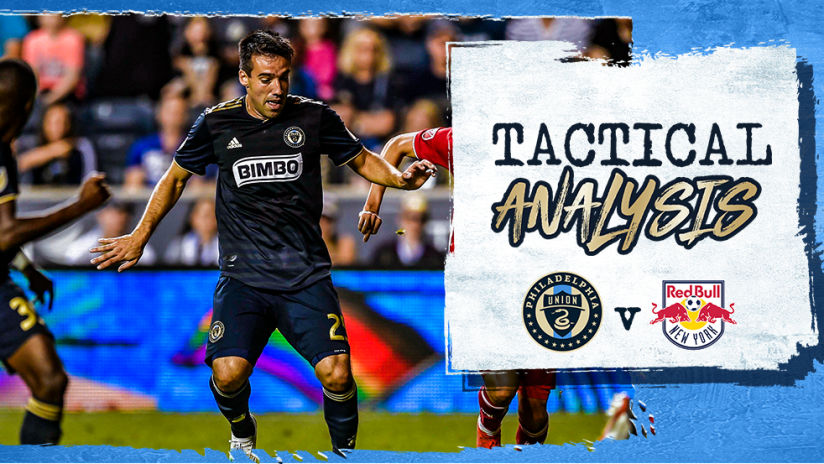There was never going to be a pretty game of soccer when Red Bulls and the Union met in the final match before both teams hit the 2019 Gold Cup break.
Even though Chris Armas has scaled back the extent to which his team pushes soccer toward rugby, the emphasis on sprinting, trapping, and transitions that has rocketed Jim Curtin’s side up the standings meant this was going to be a wide-open, back and forth game with few extended possessions.
Sure enough…
A secret ingredient in New York’s success over recent seasons is that while they recruit athletes who can run and press endlessly, the club elevates those who can make correct decisions when granted enough time to look up.
Sean Davis and Daniel Royer both excel in this regard, and now that he has a consistent starting role, Marc Rzatkowski is beginning to blossom on the ball. His long passes are not aimless, and he looks in behind the back four immediately when his head goes up. A long, angled pass to Kyle Duncan set up the first Red Bulls first before Alex Muyl played a similarly well-placed ball into space for the second.
When the Union kept heads down, however, they were able to largely control the game despite being far from their best. The Red Bulls generated only two shots following Ilsinho’s entry into the match and the Union’s switch to a 4-2-3-1. One of those was a Brian White breakaway, but the other was a tame Marcus Epps (hi!!!) shot from distance. Once Ilsinho topped off the team’s gas tank with belief, the rest of the squad bought in and there was no let up.
Two other players should be highlighted for their second half efforts. First, Jamiro Monteiro, who was off his game in the first forty-five. A step slow and spending too long on the ball in his first showdown with Red Bulls, Monteiro wasn’t the ball-moving tacklemonster he has been monst games this season. That changed in the second half when Monteiro calmly slotted home the first goal and imposed himself defensively in the center of the pitch.
Monteiro’s second half is notable because it’s increasingly clear that Jim Curtin’s team is comfortable instituting an innovating midfield setup that takes principles from aggressive pressing systems and adjusts personnel accordingly. Philly plays in a 4-2-3-1 with their playmaker in a deep-lying position and their destroyer at the No. 10.
Want evidence that sticking to a 4-2-3-1 doesn’t mean tactical inflexibility? Imagine this same shape with Borek Dockal instead of Jamiro Monteiro. That’s an entirely different playing system in the exact same formation.
Essentially, Curtin and his team looked at their playing principles and realized that Monteiro and Medunjanin’s unique skillsets meant they could try something novel. Since the Union aim to create turnovers high up the pitch and transition quickly, they move the destroyer forward to disrupt buildup play and attack before other teams can find their primary creators.
Meanwhile, Medunjanin’s abilities on the ball means that when he’s deep he can receive the first pass out of the back and instigate quick transitions even when the Union don’t necessarily have advantageous field position.
It’s absolutely fine if every one of Medunjanin’s long passes doesn’t find its mark because the Union, like the Red Bulls, prioritize getting numbers around loose balls.
For all the praise Curtin and his staff have received this season, the extent to which they have achieved that success by taking the innovative ideas Tanner brought to Philly and pushing them even further has been underplayed.
The second player that deserves a call-out is Ale Bedoya. Over the first half of the season, Bedoya has played as a left-sided No. 8, a right-sided No. 8, a midfield pivot, and a right back. That flexibility has allowed the Union to move between 4-4-2s, 4-2-3-1s, and, late in games, what amounts toa 4-3-3/3-4-3 with Bedoya covering the entire right half of the pitch so Ilsinho can stay high.
After moving to a pivot role on Saturday, Bedoya had an assist, two interceptions in the opponent’s half, and only one incomplete pass. Wait, context required: That incomplete pass hit a hand in the box and led to a penalty.
Gini Wijnaldum started over and over for Liverpool FC this season, and he started in the Champions League final. Although he doesn’t score or play flashy passes very often, Wijnaldum’s intelligence — including his ability to adjust his role depending on the other player used around him — made him indispensible for much of the year.
Bedoya has a similar effect on the Union. Since he can immediately change how he plays to accommodate anybody brought in in front of him — Ilsinho, Fafa Picault, David Accam — or behind him — Ray Gaddis, Jack Elliott, Mark McKenzie, Olivier Mbaizo — the captain allows those around him to play to their strengths by helping them avoid their weaknesses. It’s a rare gift, and one that is difficult to suss out through the limited view of television (it’s definitely worth seeing Bedoya’s off the ball work live).
Finally, do we need to analyze Ilsinho?
Here’s the important point: Red Bulls knew the sub was coming and they still couldn’t do anything about it. Ale Bedoya said that he knew exactly what Ilsinho needed to do at halftime, and he made sure the Brazilian could do it before Red Bulls had coordinated their numbers to keep extra bodies near the magician.
This was a big win, but it was hardly different from the other eight this season: The Union had a plan, they had options for each scenario, and when it came time to execute: They did.













